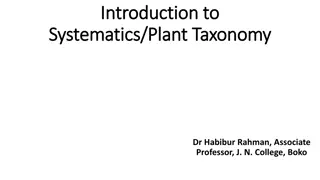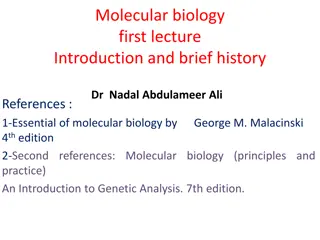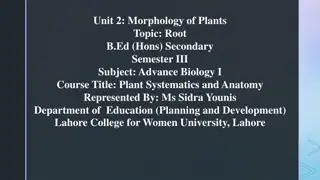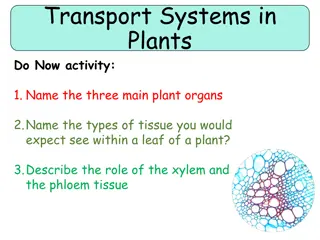Understanding Plant Developmental Biology and Model Systems
Plant development involves various processes like embryo formation, seed germination, and organ differentiation. Advances in plant developmental biology have led to the study of Arabidopsis as a model system, helping understand plant growth and genetics.
Download Presentation

Please find below an Image/Link to download the presentation.
The content on the website is provided AS IS for your information and personal use only. It may not be sold, licensed, or shared on other websites without obtaining consent from the author. Download presentation by click this link. If you encounter any issues during the download, it is possible that the publisher has removed the file from their server.
E N D
Presentation Transcript
MODEL PLANT SYSTEM MODEL PLANT SYSTEM
Learning objectives After this class learners would be able to Understand basics of plant developmental biology Different phases of development Plant diversity and groupings Properties of model systems Arabidopsis as model system
Plant development involves multiple processes as: The formation of a complete embryo from a zygote Seed germination The elaboration of a mature vegetative plant from the embryo The formation of flowers, fruits, and seeds Many of the plant's responses to its environment. Plant development comprises the growth and differentiation of cells, tissues, organs, and organ systems. Plant development shares many similarities with developmental processes in animals, but the fact that plants are nonmotile, photosynthetic organisms requires certain novel developmental processes in addition to the common ones.
The early work done on plant growth and development were mainly concentrated on embryogenesis. From three decades, due to advances in technology and availability of range of mutants, it became possible to effectively evaluate many more developmental progressions, thus, plant developmental biology emerged as generally accepted terminology. Plant developmental biology covers a multidisciplinary approach using skill and tools from genetics, molecular biology and cell biology to study processes in development outside the formation of the embryo (for eg., seed development, seed germination, leaf development, root development, flowering etc.). These studies on plant development, physiology, cell biology, and genetics bank on the model (or reference) plant Arabidopsis thaliana. Arabidopsis resembles other plants, including crop plants, in many but not all the processes. Early initiatives were to address biological questions in just a few model systems, such as Arabidopsis thaliana, Zea mays, Antirrhinum majus and Petunia hybrida, while the old model systems, i.e. potato, tobacco, used in regeneration and grafting experiments, were progressively abandoned.
The features that make a model system are of three types The initial choice normally comprises practical motives such as economic value, or inherent properties that suit the species selected for research laboratory use such as small size, small genome size, ease of culture, fecundity (productiveness), short generation time, amenability to genetic manipulations such as crossing and mutagenesis, and the possibility to manipulate gene function. Other beneficial desirable properties were ease of standardizations with simple and reproducible methods for isolation of DNA, RNA, proteins, transformation along with other laboratory methods. The third set of motives for usage of model were thecommunity properties, such as availability of genetic strains, reporter constructs, thoroughly annotated genomes, and repositories, databases, and stock centers.
The pre-molecular era Before gene cloning era, research in flowering plants largely involved tools of genetics important for plants of agricultural or horticultural importance, such as maize, tomato, barley, pea, petunia and snapdragon. These species captivated experimental inquisitiveness because of their features of colorful flowers in the petunia and snapdragon, presence of large chromosomes in barley and kernel colors in maize. These plants were primarily of agricultural or horticultural value thus, their research funding was easier. However, before the mid 1980s, despite of the fact that maize had many important and interesting HOMEOTIC mutants but it was tough or difficult to obtain funding for genetic studies on plant development. On the other hand, before recombinant DNA technology, both the requirement and funding were less on any agriculturally insignificant species that had no uncommon or overt features, such as Arabidopsis. Arabidopsis is only one species, growing in a limited set of environments.
International research programs were started in Arabidopsis, to create stock centers and databases to advance faster with the scientific investigations and to get deeper insight into plant biology. Last five years have seen tremendous progress made by the maize community in developing tools and resources for their system. Indicators in plant developmental biology relate to the molecular-genetic methods to study embryogenesis, autoregulation of meristems, leaf and flower initiation, leaf and flower formation and cell specification in the root. Developmental biology changed the research from descriptive to causal resulting in a number of genetic models. Future progresses in research will concentrate on the study of a specific gene activity in a genome-wide context. The building of molecular networks will allow computer modeling of biological processes and its use for predictions and further experimentation. Sequence information consequent from the multiple genome projects will be exploited in comparative biology.
Arabidopsis thaliana (the thale cress, mouse-ear cress or Arabidopsis) is small widely studied Angiosperm that is native to Africa and Eurasia. A. thaliana is dicotyledonous species that produces small flowers (white flowers) and is considered as weed. It belongs to the Brassicaceae or mustard family. Though it is closely linked to several crops of economic importance, such as broccoli, cabbage, canola and turnip, but it is a weed. However, it was the main focus of enormous and intense biochemical, genetic, mutationonal and physiological studies for almost 40-50 years due to several important characteristics which it possess and these traits are important for laboratory studies. Like other photosynthetic plants, Arabidopsis need air, water, light along with minerals for completing all the phases of its life.
Various advantages of using Arabidopsis as important laboratory tool are Fast life cycle Numerous self progeny Can be grown in limited space Can be easily grown in a greenhouse or indoor growth chamber It has a relatively small, genetically tractable genome Easy genome manipulation using tools of genetic engineering Easier to work than any other plant genome.
Arabidopsis, also like all other flowering plants, upon dehydration can store its seeds/progeny for long durations at optimum temperature. It can be used for developing gene knockout lines Therefore, looking at easy growth, manipulation and ease of laboratory working, it has emerged as the preferred and best model system for conducting basic research. Every year the research papers involving Arabidopsis far exceed the research involving Saccharomyces, Caenorhabditis, Zebrafish, Chicken, or Drosophila, the predominant non-mammalian fungal and animal models. Arabidopsis seeds can be accommodated in a chamber no larger than a closet. A comprehensive knockout collection of Arabidopsis is available. In comparison to Arabidopsis, creation and storage of library of knockouts for flies, mouse and worms is labor and space intensive. Therefore, altogether, these properties of Arabidopsis make it an ideal model plant/organism for biological research. Arabidopsis is choice species for big and increasing scientific community studying complex and advanced multicellular organisms.
Efficient Agrobacterium tumifaciens mediated transformation can be done in A. thaliana. A. thaliana is widely used in the fields of plant science, genetics and evolution and has helped further our understanding of germination and aspects of plant growth that are important in commercial crops. Recently A. thaliana has also emerged as model organism for studying biochemical and molecular aspects of human diseases. Exploring Arabidopsis thaliana has allowed tremendous advances in our understanding of plant development, hormone biology, signaling, disease resistance, pathogen defense, and abiotic stress responses. The results and observations of Arabidopsis (a eudicot) are widely applicable to numerous other plant species along with our understanding of human biology.

















































